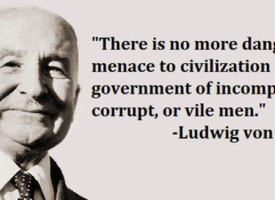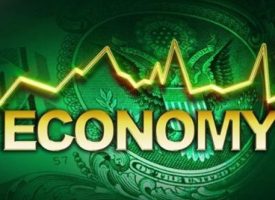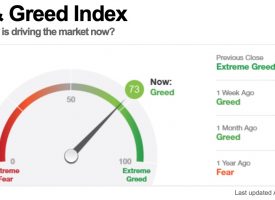As we kickoff trading in the second half of November, Dr. Stephen Leeb warned King World News that investors should expect more chaos in global markets and $25,000-$36,000 gold.
Expect A Massive, Historic Bull Market In Gold
November 17 (King World News) – Dr. Stephen Leeb: A major issue in U.S. politics today is income inequality. And indeed, there’s a strong argument that record inequalities in the U.S. have made us a less cohesive and productive society.
But even more consequential today are inequalities not within countries but between countries – specifically, between high-income countries and all the others. Gold investors in particular should pay attention to these global inequalities, because they are the major reason to expect a massive and historic bull market in gold.
Global inequalities and their implications, which I discuss below, confront the major powers – in particular, the U.S. and China, the world’s two largest economies – with a stark choice. Either start cooperating with one another or face an existential threat to civilization itself. I don’t know which of these alternatives the major powers will end up choosing. But either way, investors in gold will win big.
$25,000-$36,000 Gold
If the U.S. and China take the higher road and cooperate in tackling the world’s biggest problems, I believe that it inevitably will entail a new monetary system that is backed by gold. That will lead to a bull market in the yellow metal that will extend for years and will bring gold somewhere to $25,000 to $36,000 an ounce.
But if the U.S. and China don’t work together, and rivalries continue to rule the day, the world will likely devolve into warring factions in which today’s currencies have less and less value and gold has ever more – so again, gold wins. I don’t have a specific target price for gold under this much more dire scenario. But it would clearly imply wild inflation and gold prices that might seem beyond belief.
In other words, civilization is staring at two possible paths. One leads to a moderately bright future, the other towards one that is dark indeed. But either way, the best investment, by an ocean-wide margin, will be gold.
The basis for my analysis comes back to the global inequalities I referred to above. You can divide the world into two groups, high-income countries and everyone else. High income, as defined by the World Bank, encompasses some 80 or so countries whose average income is about $45,000 as measured in constant 2010 dollars. These countries with a population of about 1.2 billion make up bit more than 15 percent of world population, a figure that is shrinking as a result of lower birth rates in higher-income countries.
Countries outside the high-income world – known somewhat euphemistically as low- and middle-income countries – contain about 85 percent of global population and on average have a gross national income per capita of less than $5,000.
One way to put these differences into perspective is to consider that roughly speaking the 85 percent of the world in low- and middle-income countries on average survive on incomes approximately two-thirds below what the U.S. defines as poverty. This means per capita incomes for this group would have to triple simply for their average income levels to reach U.S. poverty levels.
Today’s Fractured World Order
Even that very-low-bar goal, in the context of today’s somewhat fractured world order, will be extraordinarily difficult to reach. Some argue that technology will make all these differences eventually disappear. As evidence, they cite figures that show that resources per unit of GDP have been in a steady decline for almost as long as we have data.
That’s true – but it means less than they think. The argument collapses if GDP growth is much higher than the decline in resources per unit of GDP. Why? Suppose, for instance, technology allows you to grow food with double the nutritional content it used to have. Great news: You’d only have to grow half as much to obtain the same level of nutrition. But what if the world’s population grew by fourfold? Then the same percentage of the world is still malnourished.
I’m sure some readers will protest that this is just a tired variation on what Paul Ehrlich said in 1968 in his book The Population Bomb, in which he argued that too many people and too little food meant that within a decade the world would face mass starvation and major upheaval. The world did have a lot of problems in the 1970s, 1980s and indeed up to the present, including starvation in some regions. But still the planet has survived, which many credit to the magic of technological innovation.
Ehrlich is probably better known today for the bet he made in 1980 with the late Julian Simon about the direction of commodity prices. Simon saw technology – and especially (and wrongly) nuclear energy – as being able to solve all resource problems. Ehrlich, despite a decade of waiting for upheaval, remained nearly certain that, absent population controls, some version of end times was inevitable. Two commodities were selected for purposes of the bet, and you may know the rest. In the decade of the 1980s, thanks more to Paul Volcker’s war on inflation than to technological advancements, commodity prices went down. Ehrlich lost his bet and had to pay the seemingly prophetic Simon.
Commodity Prices
Commodity prices remained tame in the 1990s as well. But since the beginning of the new century, they have dramatically outperformed other measures of inflation – supposedly ever greater technologies notwithstanding. What changed in the past generation? China emerged on the scene. The rise of China should have made us realize that technology had not solved the problem of resource scarcity. Rather the developed world had managed to sweep the problem under the rug.
Between 1990 and 2000, or for that matter between 1980 or 1970 and 2000, high-income countries experienced very strong growth while the bulk of the world remained impoverished. In 2000 about 30% of the world or 35% of the low- and middle-income world was living in what Americans would view as unimaginable poverty – less than $2.00 a day. Today, thanks to China, that percentage has been reduced to well under 10%.
But still for non-high-income countries to experience even a taste of the good life, which as I noted above is defined as U.S. poverty levels – a draconian definition of the good life – their income levels will have to rise by nearly threefold. Assuming technology continues to reduce resources needed per unit of GDP at about the same rate that China has reduced resource intensity, overall resource usage will need to nearly triple. And while oil consumption will certainly not triple, the usage of other commodities from copper to steel will likely have to more than triple.
What are the chances the world can meet the need for such a sharp rise in resources? Slim to none. And that means that on average most of the 85% of the world will not be able to reach even what for Americans is considered poverty.
China’s Ascent
China’s ascent has woken the world up – including the 85% of the world that’s outside the high-income range. It wants more than it has had to settle for – and this comes during a time when technologies both good and potentially very destructive have proliferated.
India, which not too long ago was completely impoverished, now has nuclear weapons. And while maybe we don’t need to worry about how India might employ them, that’s certainly not true of, say, North Korea. I don’t want to play Dr. Strangelove, but the world has to get its act together pronto or times could get truly tumultuous and scary.
To prevent going down this ever more fraught path, it’s essential that the resources that are available be rationed wisely, allowing the good kind of technologies – renewable energies, for one – to accelerate. I believe that can only happen if China and the U.S. can reach a rapprochement that will include something China clearly wants, a monetary system backed by gold. Implementation of such a system will lead to a bull market in gold greater than any bull market ever seen.
The Alternative Is Chaos
The alternative is chaos, which, as I noted above, also would mean far higher gold – in this case, a gold price too high even to guess at. Still, even the most fervent gold investor should hope we can avert such chaos. Having the best investment under these circumstances is better than not having it, but who knows what will be left to buy.
Note that in seeing it as essential for the U.S. and China to come together, I am by no means saying or implying the U.S. should embrace authoritarianism. We can find ways to work for the common good without shredding a drop of our freedoms.
Nor should we reflexively reject everything in China’s system. Gabriel Wildau of Bloomberg recently argued that if state subsidies work in China, they shouldn’t be anathema here. After all, the greatest research laboratory the world has ever seen – Bell Labs in its heyday – was part of a monopoly subsidized by the U.S. government.
More Bonanza Silver Grades…
Eric King: “Ivan, you just announced a second release of high grade samples from your Curibaya project — up to a jaw-dropping 8 kilos of silver, 17 grams of gold, and 7% copper. These are spectacular grades in one of Peru’s most prolific mining belts. What do you make of these continuous high grade results?”
Ivan Bebek: “Eric, the metal endowment of multi kilo silver, half ounce gold, and multi percent copper is exceptional. In my 22 years of being in the business and looking at numerous projects I can’t recall the start of a project with so much widespread high grade. This is the early days of a project, so it’s difficult for us to tell anyone what it means yet other than the property has had extraordinary results and the right address – a major mining belt with some of Peru’s largest mines and it has significant amounts of high grade everywhere.”…
Eric King: “Many people have been absolutely shocked by both press releases of high grade results. What is your former Newmont technical team saying about this project?”
Ivan Bebek: “Eric, we knew there was high grade on the property, based on historical sampling, but they did not know the extent of it and they did not know if it could be expanded as it has over 6 square kilometers. Everyone is shocked by the wide spread grades, as they represent a strong mineralized system that can produce incredible grades on a world class mining trend. The project will become increasingly more exciting as we advance it through drill targeting, and lots of news is expected over the next few months.”
Eric King: “Ivan, this Curibaya project has come out of nowhere, but the major focus of Auryn has been the Sombrero Project, a tier one copper-gold swing in Peru that has drawn strong analogies to Las Bambas Mine, a gross value $60 billion ore body — the 10th largest copper mine in the world. What’s new at Sombrero and when will you get drill permits?”
Ivan Bebek: “Sombrero is a major swing for us. Our thesis is that we extended the Las Bambas mining belt to the west by 200 kilometers. This belt has 6 world class mines. As first movers we have staked 130,000 hectares of highly prospective ground that we sampled and it represents multiple opportunities for major discoveries. We expect a major permitting advancement in November and anticipate drill permits in Q1 of 2020, which is right around the corner.”
Eric King: Looking at 2020, what are some of the major catalysts?”
Ivan Bebek: “Eric, we spent 2018/19 acquiring, identifying, and advancing tier 1 discovery opportunities in Peru at our Sombrero, and now Curibaya, projects. 2020 will be led by continuous discovery drilling amongst both projects sequentially through the year and into the following year. We also believe a significant move in commodity prices will compliment any discoveries we make. The expensive time of waiting for a drill permit will soon be behind us and we will be in a position to constantly be drilling potential major discoveries throughout 2020.” Auryn Resources, symbol AUG on the New York Stock Exchange and in Canada. To read the press release of the remarkable results CLICK HERE.
***KWN has now released Gerald Celente’s powerful audio interview discussing what investors should do to prepare themselves for the coming depression, including what to expect from gold, and you can listen to it by CLICKING HERE OR ON THE IMAGE BELOW.
Major Bottom In Gold, Plus Banking And Fed Concerns
READ THIS NEXT! Last Time This Happened We Saw A Major Bottom In Gold! Something Funny In Banking Sector & Fed Balance Sheet Concerns CLICK HERE TO READ.
© 2019 by King World News®. All Rights Reserved. This material may not be published, broadcast, rewritten, or redistributed. However, linking directly to the articles is permitted and encouraged








